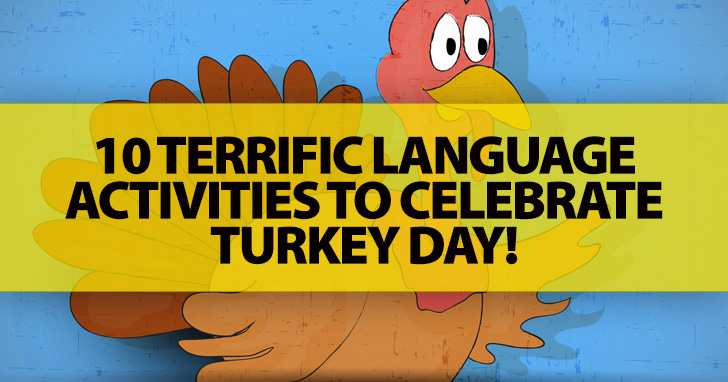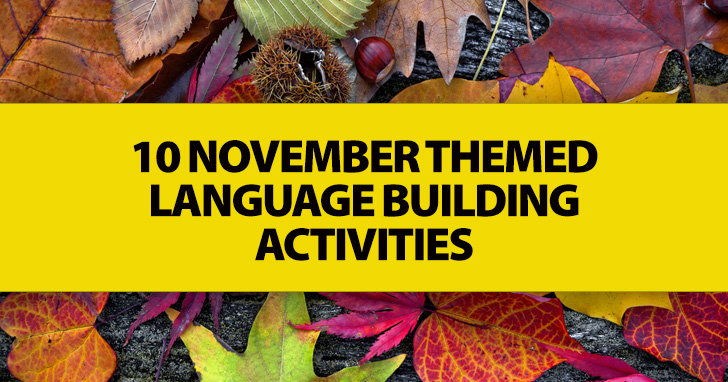10 Terrific Language Activities to Celebrate Turkey Day!


The weather is getting brisk and the days are getting shorter for ESL students in North America. Everyone has lots of activity and fun to look forward to as the holidays approach and the year nears its close. These activities are just perfect for your ESL students in the month of November.

November 3rd is National Sandwich Day, and it’s a great opportunity for your students to get creative in the kitchen. If it fits the personality of your class (allergies permitting, classroom resources, etc.) have a sandwich celebration day. Tell your students that you will bring the bread, and have everyone in class bring their favorite sandwich component. Try to avoid doubles if possible. On the day of the great sandwich event, have each person tell the class what they brought and why, paying close attention to pronunciation as they speak. Then set out all the sandwich elements and have each person go through the line making their ideal sandwich. Once the sandwiches are complete, have students return to their desks and enjoy. Follow up the activity with students writing a paragraph on what makes their perfect sandwich and why.
November 10, 1969 marks the debut of Sesame Street, the famous children’s television show. Ask your students if they have ever seen Sesame Street and what they remember from it or love best about it. You might even want to view an episode or a few of your favorite skits. Then work as a class to make a list of all the characters on the show. Have students work in groups of three or four to write a skit involving one of the Sesame Street characters. In the skit, the television character comes to your ESL classroom to learn what an ESL class is like. Have groups perform their skits in front of the class.
On November 11th, the U.S. celebrates Veterans’ Day, a day to honor and thank those who have served in the military. In many countries, military service is mandatory for young persons though in the United States it is voluntary (except during draft periods). Have any of your students done mandatory military service? As a class, discuss whether it is better to require military service from citizens or to make military service volunteer only. Follow up by asking whether we should have a special day to honor military service. Have students pay close attention to use of modal verbs during the discussion. Make sure students give reasons for their opinions.
The third Thursday of November is the Great American Smoke Out, a day the American Cancer Society encourages smokers to quit smoking or make a plan to quit smoking. It is well known that smoking is the largest preventable cause of many diseases. Yet people still smoke. In the U.S. these days, laws are changing regarding smoking. Some cities are banning smoking in restaurants. Some companies have policies banning smoking on work property or during work hours. Are these rules fair? Do they impinge on personal freedoms? Ask your class their opinions, and then divide them into two groups – one group that supports the laws and rules banning smoking and another group that thinks the rules are wrong. Have each group make a list of all their reasons for the belief they hold. Then hold a class debate on the topic.
November 17th is homemade bread day. Bread is a staple in many diets around the world. Whether it is nan, steamed buns, matzo, ciabatta, or seedless rye, most cultures have some type of bread on the menu. As a class, brainstorm different ways you can describe bread – how it tastes, smells, feels, and looks. You can use adjectives for your descriptions or more complicated structures like similes. Divide your students into groups of four or five, grouping students from different home countries if possible, to talk about their culture’s most popular bread. Encourage students to use the sensory vocabulary you brainstormed as a class.
November 21st is World Hello Day, a day that encourages world peace starting with a simple hello. Encourage your students to participate in World Hello Day by simply greeting ten people. Have groups of three or four students brainstorm different ways to say hello or greet another person (hi, how are you, good morning, etc.). If possible, have your students go to a public place and greet ten shoppers or worker using a variety of vocabulary.
Thanksgiving is a time to be thankful for what we have. The holiday reminds us to be appreciative of our blessings. When Thanksgiving comes near, encourage your students to think about the things for which they are thankful. If you teach younger ESL students, create a thankful bulletin board. Give each of your students a large construction paper feather to go on the board. On that feather, they should write what they are thankful for using complete sentences or in paragraph form. Attach everyone’s feather to a bulletin board with a large turkey in the middle. You should encourage students to write as many thankful feathers as they like. If you teach adult ESL students, you might have them write a simple five paragraph essay about some things they are thankful for. The essay should have an introduction that tells how Thanksgiving is a time to be thankful for what we have, three body paragraphs each describing one thing the writer is thankful for, and a conclusion that summarizes the writer’s points and includes some final thoughts.
If you teach children in your ESL class, you might want to use Thanksgiving to teach or review different food terms. Tell your class that Americans traditionally celebrate Thanksgiving, in part, with a large meal. Show your students pictures of traditional holiday foods – turkey, mashed potatoes, stuffing, etc. Then, have students create their own perfect holiday feast. Collect several old magazines (cooking magazines are ideal for this project) and give each student a paper plate and some glue. Have your class cut pictures out of the magazines and glue them on their plates to make the perfect holiday meal. Once students are finished, let them take turns in the front of the class naming the foods on their plate. You can display the finished projects on a bulletin board titles “The Finest Feasts”. You may also choose to surround the plates with the food vocabulary your students learned from the activity.
Thanksgiving is the most popular time of year to travel. Some might say the tradition started when the pilgrims first came to America. Tell your students the history behind Thanksgiving including how the pilgrims left their home country and came to America as well as why they came. Then put your students in groups of three or four to discuss how they came to the U.S. (if you are teaching in the U.S.) and what they hoped to find or accomplish here. This is a good time to review past tenses with your students. Listen in on the group discussions and make corrections as needed.
Here is a simple game you can do any time you have a few minutes to fill in class. Write the word Thanksgiving on the board, and challenge your students to write as many words as they can using only the letters in it. For example, they might write thanks, sank, sing, has, etc. Review all the words once time is up and define any new vocabulary as needed. Make sure you make your own list of words when your students do to increase the number of new vocabulary words for your students. If your class likes the challenge, repeat the activity using other Thanksgiving themed words like pumpkin pie, turkey, or mashed potatoes.